Where to See Big Cats in the Wild
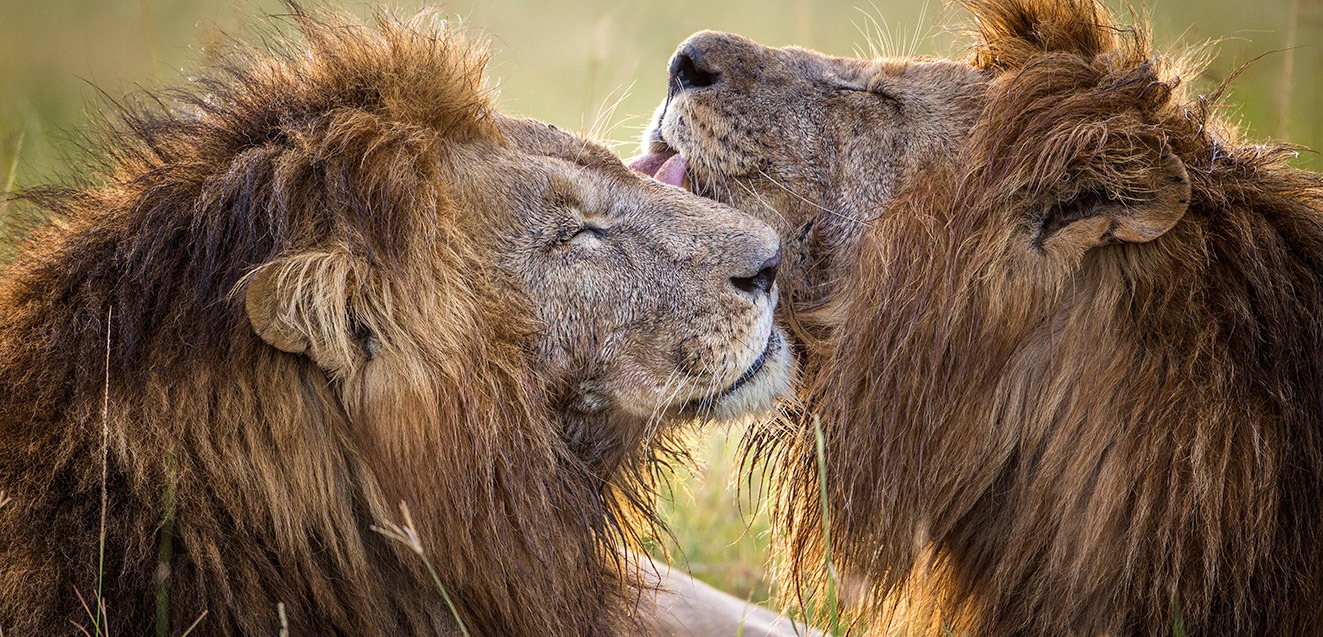
Big cats are some of nature’s most fabled wildlife, occupying storied landscapes that include Kenya’s Maasai Mara, Chile’s Torres del Paine National Park, and India’s Ranthambore National Park. Seeing these carnivorous felines in the wild can be exhilarating and unforgettable. It can also be challenging: many of these species avoid interaction with humans, live in remote regions that require complex logistics to access, and are best spotted with the help of a guide who’s knowledgeable about their behaviors. GeoEx can help. Whether it’s a tree-climbing lion or a river-swimming jaguar you’re after, here are the world’s big cats and the best places for spotting them in the wild.
Leopard
Leopards have the widest range of all big cats, an area that includes approximately 75 countries across Africa and Eurasia, as well as a broad variety of habitats—from lush rainforests to arid deserts. According to the International Union for the Conservation of Nature (IUCN) Red List of Threatened Species, their populations vary in threat from Vulnerable to Critically Endangered, due to issues like habitat fragmentation and poaching. Mostly solitary and nocturnal, these rosette-spotted carnivores comprise nine subspecies, including the African leopard and the Sri Lankan leopard, of which there are approximately between 700 and 950 remaining in the wild. Thankfully, this latter subspecies is protected under the country’s Fauna and Flora Protection Ordinance, which makes it an offense to hunt, harm, kill, or keep wild leopards.
Where Can You See Leopards?
Their vast range means you can seek out leopards in Africa and Asia!
In Africa, GeoEx’s Namibia expeditions take travelers to the country’s Okonjima Nature Reserve, where leopard sightings are a frequent part of safari excursions. Okonjima is also home to The AfriCat Foundation, a non-profit that aims to ensure the survival of Namibia’s predators—including its leopards—in their natural habitat while also contributing to conservation. This includes tracking leopards with VHF collars to help study their territorial range as well as the relationships between different predator species.
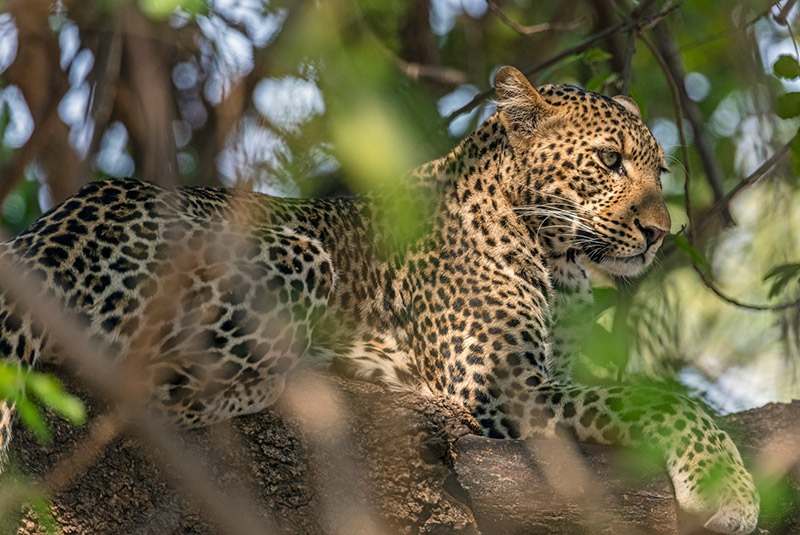
GeoEx Difference: GeoEx guests have special insider access to go behind-the-scenes. Travelers have the chance to “step into the boots” of a wildlife vet at the AfriCat clinic or ride along with a ranger on the reserve during their stay at AfriCat.
If you’re more inclined toward a private trip, GeoEx’s customizable Treasures of Zambia itinerary brings guests to the “Valley of the Leopard” itself: South Luangwa National Park. Its riverine ecosystem and abundance of trees—a preferred habitat for this tree-climbing species—means that it’s possible to enjoy multiple exhilarating sightings of this famously elusive cat.
To see the Sri Lankan sub-species, head to Sri Lanka’s Yala National Park, which is renowned for its leopard population and has a mix of habitats, including jungle, grasslands, and lagoons. Travelers can spend time at the Wild Coast Tented Lodge, which sits adjacent to the park.
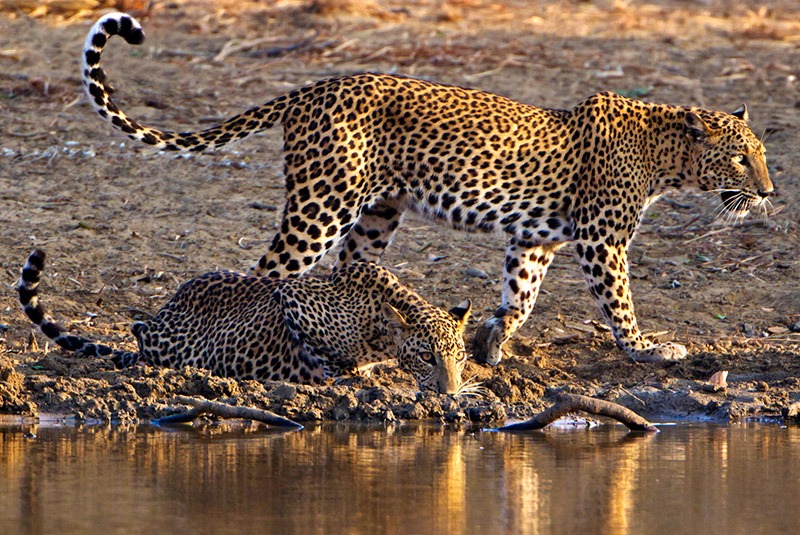
GeoEx Tip: Be aware of Yala’s seasonal closures; if you’re traveling during those periods, you may find a great alternative in Sri Lanka’s massive Wilpattu National Park.
Lion
Most of the world’s wild lions live on the African continent: in the grasslands, scrub, and open woodlands below the Sahara Desert. However, there’s also a small population of about 600 or so Asiatic lions residing amid the teak and acacia trees of western India’s Gir Forest National Park.
Lions are the largest of Africa’s big cats, with several distinct species and subspecies. These include the white lions of Timbavati, South Africa, whose lack of pigmentation comes from a rare color mutation; and the black-maned lions of Kalahari, Botswana, a desert-adapted lion that’s known for its leaner body and impressive strength. Lions typically live together in prides of about 30 or so, often sleeping throughout the day and hunting prey at night.
Where Can You See Lions?
The number of wild lions in Kenya has increased approximately 25 percent (from approximately 2,000 to 2,489) since 2010, thanks to an increase in lion conservation efforts. In fact, Kenya’s greater Maasai Mara is home to approximately 850 to 900 lions, as well as an essential stop on GeoEx’s custom Kenya: Essence of a Continent trip.
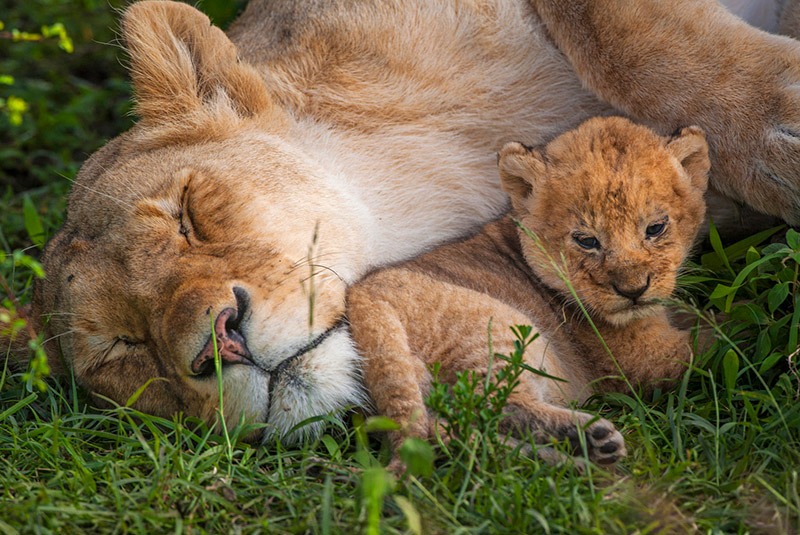
If you are looking for a unique sighting of lions, Uganda’s Ishasha sector of Queen Elizabeth National Park—which GeoEx visits on its custom Mountain Gorillas of Uganda excursion—offers one of the most famous places where you can see tree-climbing lions in Africa. Dozens of them are often seen lounging in the branches of fig trees, a natural adaptation that helps protect them from insect bites on the ground. Here in this landscape of open savannahs and tropical rain forests, GeoEx can even arrange the opportunity to track lions alongside a scientific researcher.
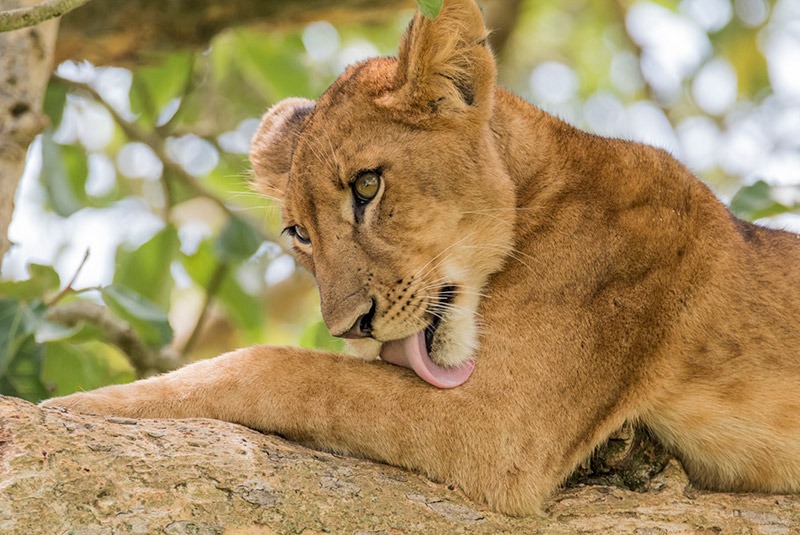
GeoEx Difference: When traveling to Kenya, ask your trip planner about scheduling a visit to speak with an Ewaso Lions Trust researcher and learn about their work in community-centered lion conservation.
GeoEx Tip: If you’d like to try your luck at seeing the tree-climbing lions, book a safari that includes Queen Elizabeth National Park or Tanzania’s Lake Manyara National Park—two areas where this interesting behavioral adaptation is most likely to be seen.
Cheetah
Cheetahs can reach speeds upwards of 80 mph. However, despite being the fastest land mammal on earth, the IUCN still considers their numbers to be Vulnerable across Africa, where they reside in the eastern and southern ranges south of the Sahara Desert. Over the last 150 years, cheetahs have actually lost approximately 90 percent of their historic range due in large part to climate change and habitat destruction. In fact, these spotted cats were once widely spread across Asia as well but are now limited to an isolated population of only about 50 or so in central Iran—approximately six percent of the less than 8,000 estimated cheetahs remaining on earth.
Where Can You See Cheetahs?
The world’s largest population of free-ranging cheetahs (approximately 2,500) reside in Namibia, with notable numbers in Okonjima Nature Reserve and Etosha National Park, both strongholds of conservation. On a custom Namibia safari, travelers can pay a visit to each of these unique ecosystems for opportunities to see these cats in the wild, and can also set up a custom experience with The AfriCat Foundation. For example, GeoEx guests can spend the day with one of their vets to learn about advancements in the health and welfare of captive cheetahs.
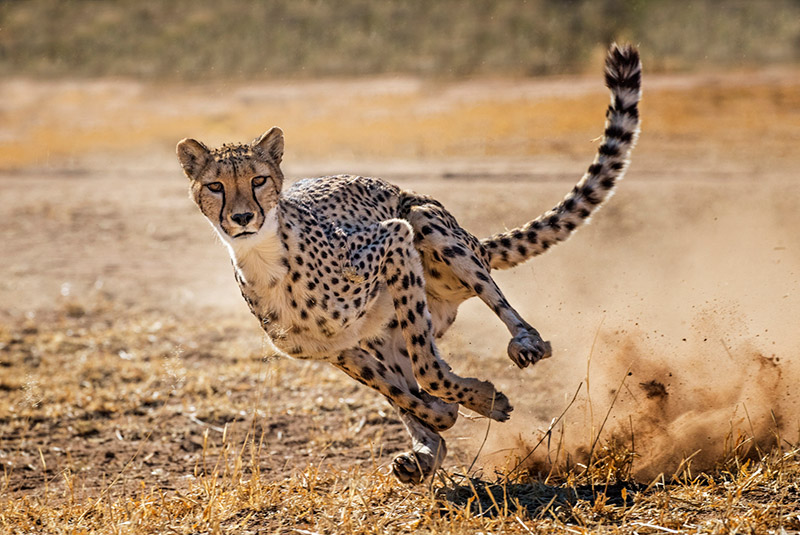
Other great places to spot cheetahs include the lowland areas of southern Africa’s Kalahari Desert and Tanzania’s Serengeti. GeoEx’s The Nature of Tanzania is a customizable itinerary that places you right in the middle of some of the cheetah’s preferred flat, savannah habitat. Ask about a stay at Namiri Plains, a Serengeti camp that spent twenty years as a cheetah research station before opening up to the public for safaris.
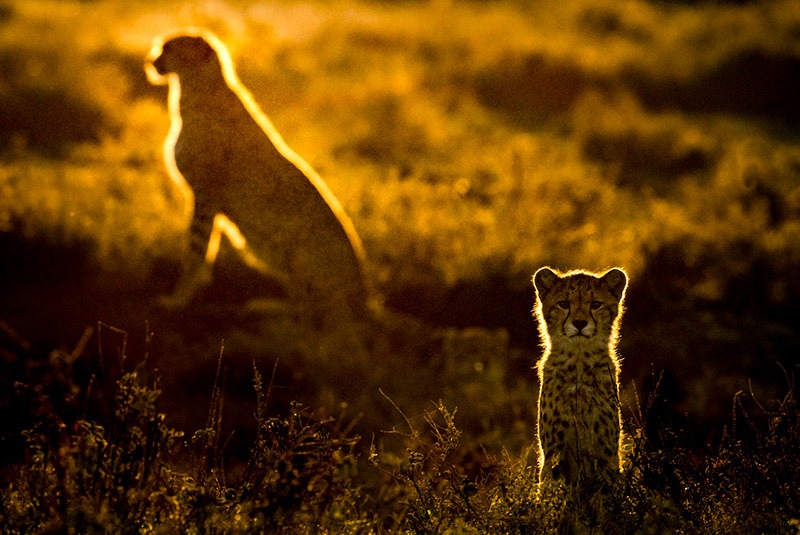
Tiger
The tiger is Earth’s largest living cat species: massive Panthera—most recognizable by their stripes and can weigh over 675 pounds. Historically, tigers lived throughout Asia, though an estimated 95 percent of their territory has been lost due to such factors as habitat fragmentation and destruction, poaching, and even retaliatory killings caused by wildlife-human conflict. Today, there are only 13 countries in which tigers exist in the wild, including India, Thailand, and Nepal, as well as the Russian Far East. Although tigers are globally listed as endangered by the IUCN, their Malayan and Sumatran sub-species are considered critically endangered and forced to compete for space with human populations. Considered solitary creatures, tigers keep their territory that they mark through scent and tree scratching.
Where Can You See Tigers?
Northern India’s Ranthambore National Park is an ideal place for spotting tigers in the wild. Considered to be one of the country’s top tiger sanctuaries, it can be added to any custom trip to India. Here, travelers safari into the heart of this former royal hunting ground, where the number of Royal Bengal tigers has increased from 66 in 2019 to 81 in 2021. You may also choose to include a visit to central India’s Kanha National Park, a 363-square-mile expanse of grassland and forest known for its significant tiger population. The park’s Banjaar Tola safari lodge makes an excellent base from which to search for the powerful feline.
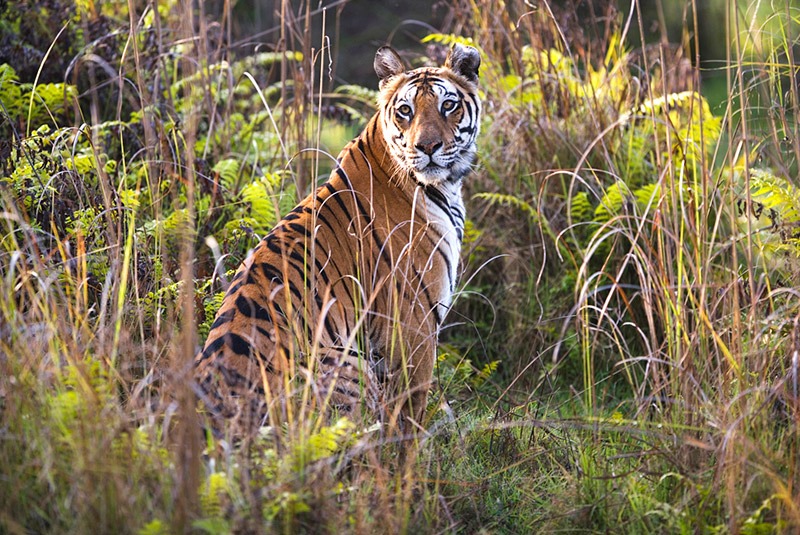
GeoEx Difference: Ranthambore is a flagship national park and can become somewhat crowded with Jeeps and 20-seater canter buses. GeoEx guests always go on safari in private vehicles. Ask your trip planner about full-day and half-day passes in Ranthambore—these allow you to enter the multiple zones that regulate access in the park, and grant you more time to search for tigers, often in greater solitude.
Additionally, Nepal is home to the UNESCO-listed Chitwan National Park, a preserved subtropical lowland featuring more than 360 square miles of dense forests, marshlands, and thick grasslands, not to mention dozens of Royal Bengal tigers. This well-managed parkland was established as the country’s very first national park in 1973 and has increased in both size and tiger population since its inception.
Snow Leopard
Known as the “ghosts of the mountains” because they’re so elusive, snow leopards are shy and solitary creatures that inhabit some of the earth’s highest reaches of a dozen mountainous countries across northern and central Asia, including Bhutan, Afghanistan, Mongolia, and India. These big cats seem almost mythical, preferring to live above the treelines up to 18,000 feet in elevation, where their thick and spotted whitish-to-gray fur blends seamlessly with the snow-covered landscape, making them extremely difficult for their prey—as well as humans—to see. The IUCN considers snow leopards to be a Vulnerable species due to various threats that include poaching, habitat loss, and the effects of climate change. It’s estimated that between 4,000 and 6,500 snow leopards remain in the world, with more than half of them living in China.
Where Can You See Snow Leopards?
Mongolia’s Altai Mountains are home to the second largest population of snow leopards in the world (after China), and we at GeoEx believe this is also the best place to see them in the wild. The reason is that the snow leopards here reside at much lower elevations (around 3,200 feet) than those in places such as northern India’s Ladakh region, where they typically live above 10,000 feet, and it’s much more comfortable hiking at lower elevations, where thicker air makes breathing easier. GeoEx can design a custom journey tracking these elusive creatures alongside an expert local guide who illuminates a broader picture through visits to mountain villages for conversations about snow leopard conservation.
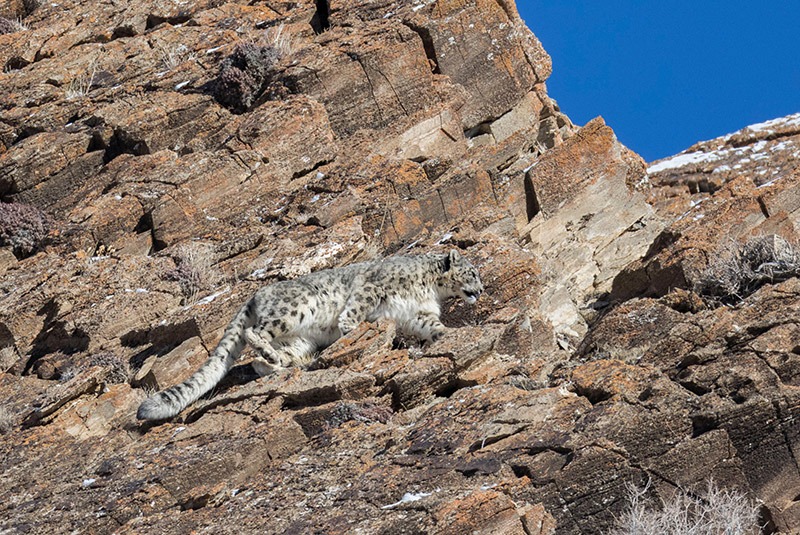
Despite the higher altitudes, Ladakh remains a favorite place for tracking snow leopards. Here, there are estimated to be between 200 and 300 of them. GeoEx can arrange a custom trip to Ladakh’s Himalayan peaks, where the elusive creatures often descend onto cliff sides and rock outcrops to feed on wildlife like ibex and bharal.
GeoEx Difference: GeoEx can arrange a meeting with the Snow Leopard Conservancy in Mongolia, learning about their monitoring and conservation efforts, and perhaps “adopting” a snow leopard!
Puma
With a range extending from the Canadian Yukon right down to the southern tip of Patagonia, you might think pumas would be easy to spot. However, due to loss of habitat, conflicts with human encroachment, and loss of prey through hunting, their populations are increasingly threatened. In North America, where they are known as cougars or mountain lions, they have been almost entirely eliminated from the eastern side of the continent. In South America, extensive parklands, such as Chile’s Route of Parks, and programs designed to educate ranchers about the value of conservation and ecotourism have helped puma populations begin to recover, resulting in improved chances of sightings for travelers. Like cheetahs, pumas aren’t part of the genus Panthera, and are therefore not considered a true “big cat,” but they remain just as impressive.
Where Can You See Pumas?
Studies point to the highest density of pumas being found in Patagonia, where one of their primary sources of prey, guanacos, are plentiful. With over ten million acres of protected parks, Chile is leading the way in restoring puma habitat. Let GeoEx plan a custom Patagonia trip to remote Patagonia National Park, where pumas patrol the edges of the steppe at dusk and dawn, offering excellent chances to spot them in the wild. In addition, choose to visit the country’s legendary Torres del Paine National Park, where pumas roam in particularly high numbers.
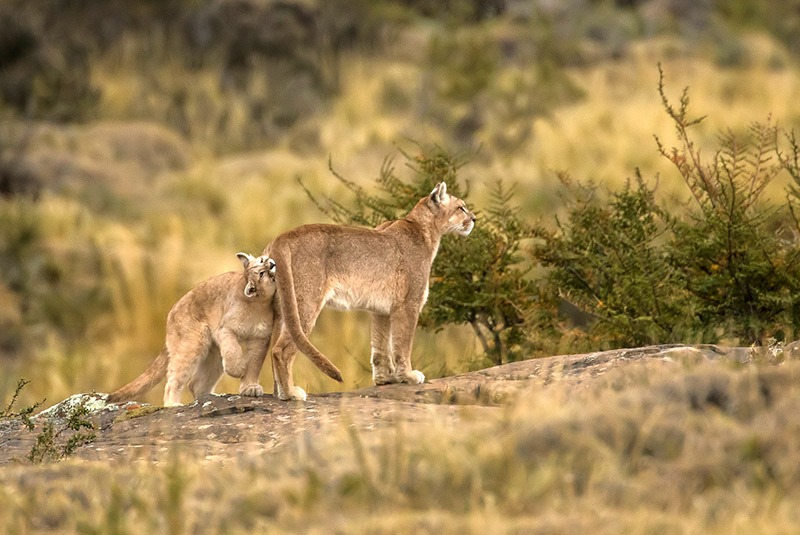
GeoEx Difference: Custom travelers hoping to glimpse the elusive puma should let their GeoEx trip planner know this is a priority. Your planner will arrange for you to stay in some of the luxurious lodges with the greatest concentration of puma sightings, such as Awasi Patagonia Lodge, where the Awasi Puma Foundation offers two different types of puma-spotting expeditions to guests.
Jaguar
Although similar in appearance to leopards, jaguars are slightly larger and significantly stockier than their Asian and African cousins. They’re also the only living Panthera species native to the Americas (the puma, of course, being the only species within the entire Puma genus). While once prevalent from as far south as the scrub grasslands of Argentina and north up to Arizona’s Grand Canyon, their population has decreased by 25 percent in just over two decades. Deforestation and illegal logging have played a big part in their drastically reduced numbers, limiting the land jaguars now have available to them for hunting and mating. Today, jaguars occupy less than half of their historical range, roaming only as far north as Mexico’s Sonora state and occasionally crossing the border into Arizona.
Today, jaguars occupy various habitats, including dry grasslands and open country, throughout South and Central America. More than half of their population resides within the Amazon rain forest and the UNESCO-listed Pantanal, a more than 70,000-square-mile tropical wetland, both of which are largely within Brazil.
Jaguars are so elusive that tracking their actual numbers has been difficult, with estimates ranging from 15,000 to 64,000 of these big cats remaining in the wild.
Where Can You See Jaguars?
The Amazon rain forest and the world’s largest tropical wetland, the Pantanal, are two great places to seek out the elusive jaguar. Delve deep into the Pantanal, journeying through woodland savannahs and flooded grasslands where jaguars can be seen hunting along riverbanks and even swimming for fish. Check out Caiman, a refuge and lodging with its own sustainability program. These efforts include the conservation-based organization Oncafari, which works to habituate jaguars to safari vehicles. Guests can then have the opportunity to view these big cats up-close without the latter feeling threatened, and learn more about the importance of jaguars—and their role in the local ecosystem—in the process.
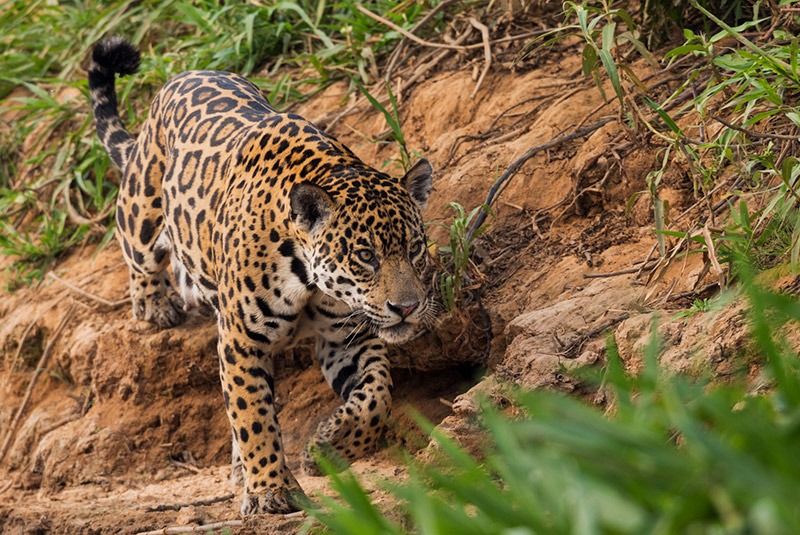
* * * * *
When planning an adventure to big cat territory, expert travel knowledge and local expertise are the keys to maximizing your chances of spotting wildlife. GeoEx has spent decades building strong relationships with top-notch guides and hands-on conservation organizations in the destinations where big cats roam free, giving our guests special access and insider perspective on these majestic creatures and their habitat. Contact one of our experts to plan your trip at 888-570-7108 or inquire online.

